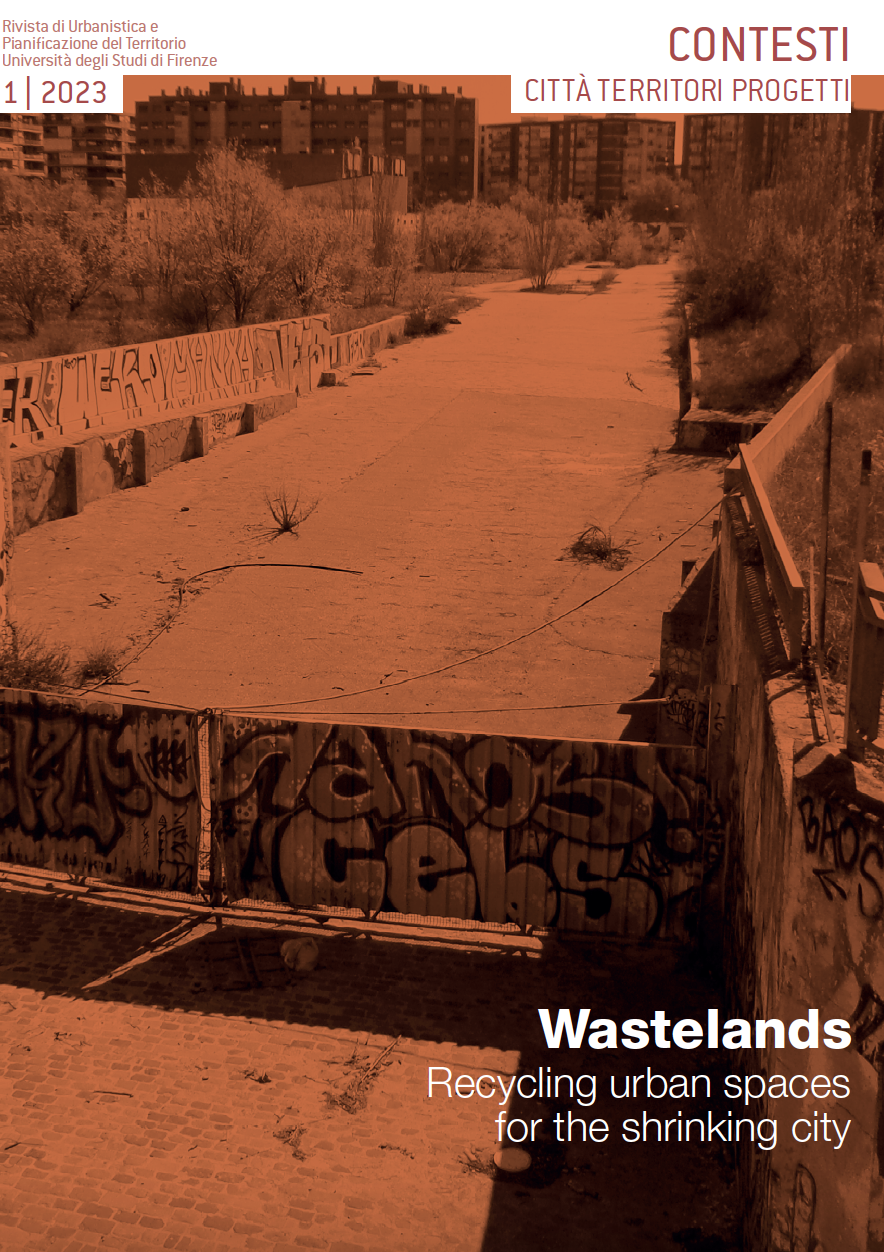How to regenerate the ordinary public spaces after Covid-19 crisis? Recommendations for planners and urban designers
Published 2023-09-12
Keywords
- Urban design,
- Daily public spaces,
- Proximity,
- Covid-19,
- Shrinking cities
How to Cite
Copyright (c) 2023 Mario Paris, Irene Caricati, Davide Vettore

This work is licensed under a Creative Commons Attribution-NonCommercial 4.0 International License.
Abstract
The paper discusses the current practices in the regeneration of public spaces starting from research that compares case studies from Milan (I) and Copenhagen (DK) developed by the authors, trying to exceed the rhetoric of the 15-min city, that nowadays is mainstream.
The aim of the paper is to identify potential approaches for designers and planners when they intervene in daily, public spaces that have lost their meaning and identities. Testing existing proposals, the study explores a set of issues that affect the physical, social, and economic condition of places and that should be considered in the process of re-activation.
Discussing the results, the study proposes a set of tools and recommendations that can support the work of urban designers and could foster the social and physical impacts of their work. The conclusions open a perspective on the role of this type of intervention in the construction of the future city.
Downloads
References
Arsuffi R. (2019), Milano | La Maddalena – Piazza Sicilia, ognuno si è sistemato il proprio lato. Available at: https://blog.urbanfile.org/2019/11/28/milano-la-maddalena-piazza-sicilia-ognuno-si-e-sistemato-il-proprio-lato/ (Accessed: 14 March 2023)
Barbarossa L. (2020) ‘The Post Pandemic City: Challenges and Opportunities for a Non-Motorized Urban Environment. An Overview of Italian Cases’, in Sustainability, 12, 7172.
Bliss L. (2020) Mapping How Cities Are Reclaiming Street Space. Available at: https://www.citylab.com/transportation/2020/04/coronavirus-city-street-public-transit-bikelanes-covid-19/609190/ (Accessed: 14 March 2023).
Casti, E., Adobati, F., Negri, I. (editors), (2021) Mapping the epidemic: a systemic geography of covid-19 in Italy. Amsterdam, Elsevier.
COBE (2016) Our Urban Living Room. Learning from Copenhagen. Copenhagen, Arvinius+Orfeus Publishing.
Comune di Milano (2019) Piazze Aperte. Milano, Comune di Milano.
Comune di Milano (2020a) Milano e i suoi Quartieri. Milano, Comune di Milano.
Comune di Milano (2020b) Milano 2020 - Strategia di adattamento. Milano, Comune di Milano.
Corner, J. (2006) ‘Terra Fluxus’, in C. Waldheim, (ed.) The landscape urbanism reader. New York, Princeton Architectural Press.
XXXX (2023) ‘Three Case Studies of Landscape Design Project of Italian Marginal Areas. An Anti-Fragile Opportunity for an Integrated Food Governance in a Post Covid Perspective’, in Cities, 135, pp. 1-12.
Ferlinghetti, R., (2019) ‘Paesaggi minimi: tra riconciliazione ecologica e salvaguardia dell’armatura territoriale’, in E. Casti, (ed.) La geografia a Bergamo. Nuove sfide per l’analisi territoriale e il mapping, Rome (I): A.Gei, pp. 57-75.
Frolov, D., Volkov, S., and Akimova, O. (2022) ‘Ecosystems of Old Industrial Cities: Complexity and Multifacetedness of Urban Shrinkage’, in R. Polkarov, (ed.) Ecosystems Without Borders. Opportunities and Challenges. Chaim (CH): Springer Nature, pp. 73-88.
Gehl J. (2020a) Public Space and Public Life during Covid-19. Available at: https://covid19.gehlpeople.com/ (Accessed: 14 March 2023).
Gehl J., (2020b) Public Space and Public Life in the reopening phase. Available at: https://covid19.gehlpeople.com/ (Accessed: 14 March 2023).
Gehl, J. (2011) Life between buildings. Copenhagen, The Danish Architectural Press & The Royal Danish Academy of Fine arts.
Gehl, J., (2004) Public spaces public life – Copenhagen. Danish Architectural Press, Copenhagen.
Gehl, J. & Gemzoe L., (1996) Public Spaces. Public Life. Copenhagen, Denmark: The Danish Architectural Press and Royal Danish Academy of Fine Arts, School of Architectural Publishers.
Han, S., Sim, J., Kwon, Y. (2021) ‘Recognition Changes of the Concept of Urban Resilience: Moderating Effects of COVID-19 Pandemic’, Land, 10, 1099.
Laker L. (2020), World cities turn their streets over to walkers and cyclists. Available at: https://www.theguardian.com/world/2020/apr/11/worldcities-turn-their-streets-over-to-walkers-andcyclists#maincontent (Accessed March 14, 2023)
Lydon, M., Garcia, A. (2015) Tactical Urbanism, Washington, Island Press.
Marchegiani E., Bonfantini B.G. (2022), ‘Urban Transition and the Return of Neighbourhood Planning. Questioning the Proximity Syndrome and the 15-Minute City’, in Sustainability, 14(9), 5468.
Martinez-Fernandez, C., Audirac, I., Fol, S., and Cunningham-Sabot, E. (2012) ‘Shrinking Cities: Urban Challenges of Globalization’, International Journal of Urban and Regional Research, 36(2), pp. 213–225.
Nieuwenhuijsen M. (2020) Covid-19 and the City: the Covid-19 pandemic and the transformation of the city. Barcelona, MJN Publisher.
O’Sullivan, F. (2020) Europe’s Cities Are Making Less Room for Cars After Coronavirus. Available at: https://www.citylab.com/transportation/2020/04/coronavirus-reopencities-public-transit-car-free-bike-milan/610360/ (Accessed March 12, 2023).
OECD (2020) City, policy responses. Available at: https://www.oecd.org/coronavirus/policyresponses/cities-policy-responses-fd1053ff/ (Accessed March 12, 2023).
Peterson, A.L., (2017) ‘Exporting Strategies for Urban Livability: Examining Copenhagen, Denmark as a Model City for Quality of Life Generated through Denmark as a Model City for Quality of Life Generated through Urban Design’. MS Thesis and Project at Trinity College.
Rieniets, T. (2005) ‘Global shrinkage’, in P. Oswalt, (ed.) Shrinking Cities: Volume 1: International Research. Ostfildern-Ruit, Hatje Cantz, pp. 20–34.
Rossi, M., Perrone, C. (2020) ‘Homing city. Un progetto di ricerca sulla gestione degli spazi minimi di prossimità nel welfare per il superamento delle crisi pandemiche’, in Contesti, 2, pp. 119–130.
Schön D.A. (1985) The reflective practitioner. New York, Basic Books.
Sposini, R. (2020) Milano, Cosa Prevede Strade Aperte, Il Progetto per Ridurre l’Uso Dell’auto Nella Fase 2. Available at: https://www.lifegate.it/milano-cosa-prevede-strade-aperte-progetto-auto-fase-2 (Accessed: March 12, 2023).
UN-Habitat (2021) Cities and Pandemics: Towards a More Just, Green and Healthy Future. Nairobi, United Nations Human Settlements Programme.
Wiechmann, T., Bontje, M. (2015) ‘Responding to Tough Times: Policy and Planning Strategies in Shrinking Cities’, European Planning Studies, 23(1), pp. 1-11.


